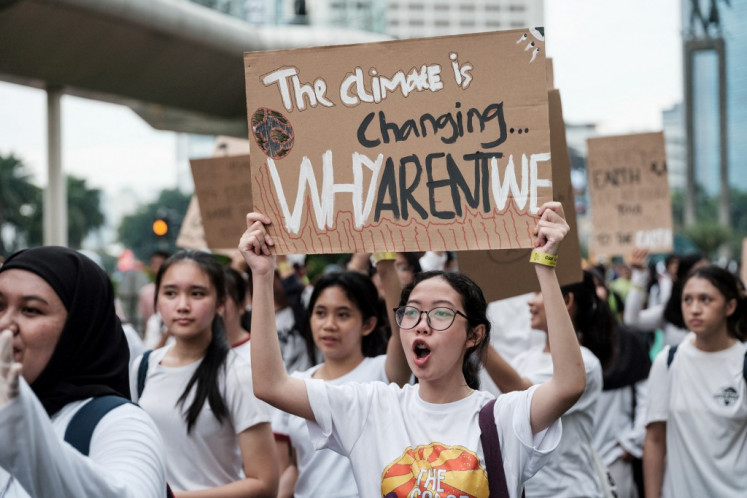How employers in Indonesia can harness the full potential of female employees
In the past few years, Indonesia has experienced an average of 5 percent annual gross domestic product (GDP) growth. This could be partly attributed to the increasing population of women in the workforce—almost five times as more in the past three years alone. Yet, Indonesia was ranked only 88th in the World Economic Forum’s Global Gender Gap Report 2016.
Change Size
 Indonesia was ranked only 88th in the World Economic Forum’s Global Gender Gap Report 2016. (Shutterstock/File)
Indonesia was ranked only 88th in the World Economic Forum’s Global Gender Gap Report 2016. (Shutterstock/File)
I
n the past few years, Indonesia has experienced an average of 5 percent annual gross domestic product (GDP) growth. This could be partly attributed to the increasing population of women in the workforce—almost five times as more in the past three years alone.
Yet, Indonesia was ranked only 88th in the World Economic Forum’s Global Gender Gap Report 2016. At the corporate level, creating the conditions to increase participation of women in the workforce remains challenging and complex.
Where should employers begin?
Diversity and inclusion requires deliberate effort. In Indonesia, many organizations have identified diversity management as a top priority and set minimum quotas for hiring women in their organizations, together with strategies to meet these quotas.
In the recent Aon Best Employers Indonesia study, it was discovered that engagement levels among women have increased 1.8 percent year on year from 2013 to 2016—despite the decrease across Indonesia. While there is no one-size-fits-all solution, and the drivers for engagement are dynamic to each organization, the study showed that there are common traits among organizations where the engagement levels for women exceed the market average by a substantial 20 points.
Provide infrastructure conducive to women
In Indonesia, most young women leave their jobs when they become mothers because they don’t get sufficient support on meeting the needs of their children and families. These women may also turn down leadership positions, even though they have been identified as highly talented—which is a wasted opportunity for both the individual as well as the organization.
Yet this significant problem has a simple solution: Provide infrastructure at the workplace to support young mothers, such as nursing rooms and childcare facilities—reasonably low investments that come with extremely high perceived value to female employees.
(Read also: Here's why Jakarta needs to improve its daycare service)
Allow for flexible work arrangements
Flexible work arrangements usually come in two ways—flexible working hours allows employees to work any 8 hours of the day (not strictly from 9 a.m. to 5 p.m.); while flexible working spaces allows employees to work remotely, either at home or another office closer to their home. Many women employees at Best Employers Indonesia organizations have benefited from these schemes, and believe it helps them to achieve the level of work-life balance they desire.
Offer attractive career and learning opportunities
Women look for employers who offer equal and attractive opportunities for learning and development as well as career progression. Seventy-nine percent of Aon Best Employers in Indonesia already do this, compared to the market average of just 63 percent, which leads to a lower attrition rate among women. At the same time, organizations also benefit from having a more qualified—and engaged—pool of talent in the succession pipeline.
Develop women leaders actively
When succession pipelines are inadequate and middle management roles remain unfilled, supervisors grow overworked while employees grow unmotivated. By offering equal opportunities for women, identifying those who belong in the succession pipeline is a natural process—while still being sensitive to their personal and family commitments.
One Aon Best Employer in Indonesia does this by creating an informal women’s support group within the organisation, which focuses on widening the women’s network and provides a safe forum for an exchange of ideas as well as support for newcomers. What’s more, the network helps to increase female employees’ awareness in what career and leadership opportunities are available—which, in turn, helps the organization proactively extend the pipeline of capable women for leadership roles.
(Read also: Leading women's empowerment)
What does the future look like?
This year, 24 percent of Aon Best Employers filled vacancies in managerial positions with current female employees, compared to only 13 percent in the market; while almost 40 percent have programs to specifically develop female employees with high potential, which shows a strong desire to prepare women for leadership roles.
This demonstrates the immense future potential for women in the Indonesian workforce, considering the top five engagement drivers selected by women employees themselves: performance management (84 percent), learning and development (82 percent), supervision (82 percent), rewards and recognition (81 percent) and senior leadership (77 percent).
Underlying each of these areas of strength is a commitment to diversity and inclusion, creating an environment where women in these organizations believe they are receiving the support they need from their supervisors and leaders to perform well at the workplace—without compromising on their personal commitments. Correspondingly, HR policy and processes such as flexible working arrangements are designed with the changing life stages of women employees in mind.
As the contribution of women to Indonesian business becomes increasingly significant, only the most forward-thinking employers will have the strategies in place to attract the best among them. By monitoring the engagement levels of women, not just once a year but through pulse surveys throughout the year, employers become more equipped to act on the key drivers for their women employees. There is no better time than now for Indonesian employers to harness the full potential of the women in their workforce.
---------------
Interested to write for thejakartapost.com? We are looking for information and opinions from experts in a variety of fields or others with appropriate writing skills. The content must be original on the following topics: lifestyle ( beauty, fashion, food ), entertainment, science & technology, health, parenting, social media, travel, and sports.Send your piece tocommunity@jakpost.com. For more information click here.









